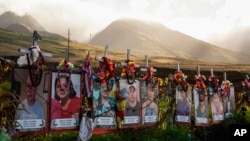The Maui Fire Department is expected to release a report Tuesday detailing how the agency responded to a series of wildfires that burned on the island during a windstorm last August — including one that killed 101 people in the historic town of Lahaina and became the deadliest U.S. wildfire in more than a century.
The release comes one day before the Hawaii Attorney General is expected to release the first phase of a separate comprehensive investigation about the events before, during and after the Aug. 8 fires.
The reports could help officials understand exactly what happened when the wind-whipped fire overtook the historic Maui town of Lahaina, destroying roughly 3,000 properties and causing more than $5.5 billion in estimated damage, according to state officials.
The Western Fire Chiefs Association produced the after-action report for the Maui Fire Department. After-action reports are frequently used by military organizations, emergency response agencies, government entities and even companies to help identify the strengths and weaknesses of the organization's response to an emergency.
A similar after-action report was released by the Maui Police Department in February. It included 32 recommendations to improve the law enforcement agency's response to future tragedies, including that the department obtain better equipment and that it station a high-ranking officer in the island's communications center during emergencies.
Hawaiian Electric has acknowledged that one of its power lines fell and caused a fire in Lahaina the morning of Aug. 8, but the utility company denies that the morning fire caused the flames that burned through the town later that day. But dozens of lawsuits filed by survivors and victims’ families claim otherwise, saying entities like Hawaiian Electric, Maui County, large property owners or others should be held responsible for the damage caused by the inferno.
Many of the factors that contributed to the disaster are already known: Strong winds from a hurricane passing far offshore had downed power lines and blown off parts of rooftops, and debris blocked roads throughout Lahaina. Later those same winds rained embers and whipped flames through the heart of the town.
The vast majority of the county’s fire crews were already tied up fighting other wildfires on a different part of the island, their efforts sometimes hindered by a critical loss of water pressure after the winds knocked out electricity for the water pumps normally used to load firefighting tanks and reservoirs. County officials have acknowledged that a lack of backup power for critical pumps made it significantly harder for crews to battle the Upcountry fires.
A small firefighting team was tasked with handling any outbreaks in Lahaina. That crew brought the morning fire under control and even declared it extinguished, then broke for lunch. By the time they returned, flames had erupted in the same area and were quickly moving into a major subdivision. The fire in Lahaina burned so hot that thousands of water pipes melted, making it unlikely that backup power for pumps would have made a significant impact.
Cellphone and internet service was also down in the area, so it was difficult for some to call for help or to get information about the spreading fire — including any evacuation announcements. And emergency officials did not use Hawaii’s extensive network of emergency sirens to warn Lahaina residents.
The high winds made it hard at times for first responders to communicate on their radios, and 911 operators and emergency dispatchers were overwhelmed with hundreds of calls.
Police and electricity crews tried to direct people away from roads that were partially or completely blocked by downed power lines. Meanwhile, people trying to flee burning neighborhoods packed the few thoroughfares leading in and out of town.
The traffic jam left some trapped in their cars when the fire overtook them. Others who were close to the ocean jumped into the choppy waters to escape the flames.











